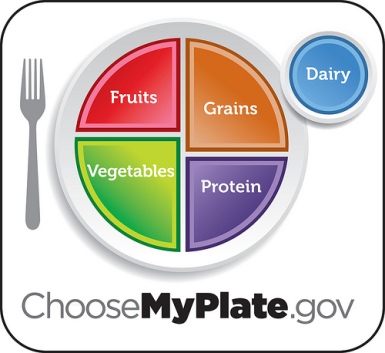Although food guides have been around in the United States since the late 1800s, it wasn’t until the 1960s that the Food Pyramid as we know it really took shape. As today’s parents, we grew up seeing the colorful pyramid built with rows of blocks consisting of various widths demonstrating how much of each food group we should eat. The layers later became vertical, somewhat resembling a striped circus tent, but the concept was still the same. However, this dietary wonder has now become a relic of the past as MyPlate made it’s national debut and entered our kitchens in mid-2011. While the pyramid of old typically required far too many words of explanation, and the overall lack of understanding posed a pretty big problem, our hope is that the visually appealing MyPlate will make the important nutritional message it serves much easier to digest.
Breaking down MyPlate
The simple image of a plate is neither earth shattering nor groundbreaking, but it does represent a pattern of eating that many of us have advocated for years. The premise behind MyPlate is that all the food you eat on a plate should be divided into certain categories:
- Fruits and vegetables taking up one half of the plate
- Meats/proteins and grains (ideally whole grains) each getting a quarter
- On the side is a serving of dairy
Sure, in our heart of hearts, we already know that we should be eating lots more fruits and vegetables (interspersed with some whole grains and lean protein but there’s no denying that a picture speaks a thousand words. In other words, the new plate illustration should make the comparison with one’s own plate full of food much easier—including making it easier to recognize if and when there’s a striking lack of fruits and vegetables.
That said, there’s a big difference between knowing what we should be doing (or in this case, eating) and what we actually do or eat. When it comes to MyPlate, it’s important to look beyond the colorful picture and commit to taking a closer look at other identifiable plate-related problems. This begins with the acknowledgment that far too many meals are eaten without even using a plate! Plate-less portions apply not only to snacking, but to the huge number of fast-food meals Americans eat so often that they get by without plates altogether.
When it comes to the problem of snacking and fast food alike, even just requiring the use of a plate, and making it a rule that your children (and you) have to sit down to eat off of it, could improve the situation. Combine that with a sincere effort to meet the new MyPlate recommendations and you’ll find that there’s essentially no space on the plate for most fast-food fare or other junk food.
Oversized portions (and plates)
Moving on to another super-sized plate problem: Plates themselves have gotten bigger over the years, along with everything from soda bottles and bagels to mugs and bowls. Studies indicate that the bigger the serving dish, the bigger the serving is likely to be. The more we heap on our plates, the more likely we are to overeat. To overcome this problem of overabundance, it can be helpful to eat off a smaller plate, or at least resist the urge to fill it.
And finally, we believe that trying to model your plate on MyPlate has the added benefit of opening new dietary possibilities. Many people seem to have quite a few preconceived notions about what’s appropriate to eat for breakfast, lunch, and dinner. Even those who eat the recommended proportions of fruits, vegetables, grains, and protein at dinner (and maybe even lunch) might not have considered serving up this balanced approach at breakfast.
With that, we present to you MyPlate. Voilà and bon appétit!
